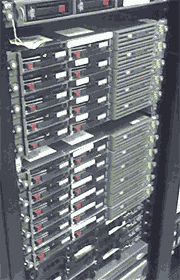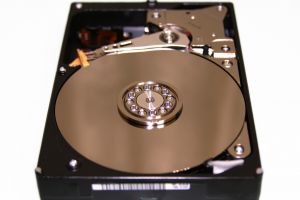Resources:
RAID 2 summary from AC&NC Corporation
Admin's RAID Data
Recovery Guide
Guide to RAID levels placing RAID 2 in context
Level 2 is the "black sheep" of the RAID family, because it is the only RAID
level that does not use one or more of the "standard" techniques of mirroring,
striping and/or parity". RAID
2 evaluation at PCGuide.com
RAID 2Definition: RAID 2 describes a specific format for redundant arrays of inexpensive disks (the origin of the acronym RAID) in which data is strongly protected from corruption. It is no longer in use, having been superseded by on-disk correction technology
The idea of using cheap PC-style disks in batches to imitate larger, more expensive disks first came along in the late 1980s. As these disks were inherently less reliable than the larger, multi-platter disks that were used in mainframes and mini-computers a lot of work was done on making the arrays resilient to failure. This lead to a number of different RAID systems becoming available using either hardware, software or both to implement various different methods that allowed systems to check that data was accurate and for disks to be swapped out easily when they failed. These different RAID formats are know as 'levels', going from level 0 to level 6, although there are numerous other non-standard, hybrid and enhanced variants. The data security methods usually involve one of three methods: mirroring, i.e. having the contents of one disk copied to another disk every time a change is made, striping, where data is spread among a series of disks, or error checking, where calculations are made on the data and the results stored to be checked against later. RAID 2 Error Checking
These error codes are then stored on a different disk
to the data they refer to and the RAID 2 controller keeps tabs on which
error code relates to which data segment. Redundancy was built into RAID 2
but an array could only recover from the loss of one drive; if another one
failed that would be the end of the whole array, which would have to be
taken off line and the data rebuilt from archives or backups. Why RAID 2 Didn't Make the Grade RAID 2 is, at the time of writing, no longer being actively developed and no products based on it have come to market for over a decade. RAID 2 never caught on in the first place because of the expense and because disk drive technology rendered it obsolete. To some extent this also afflicted RAID 3, which used striping with simple error checking (a parity check). In the days when different manufacturers used different byte and word lengths the design of a RAID 2 controller and the configuration of the array had to be different to work with different manufacturers' file systems and this prevented the idea from becoming universally popular. The arrays had to be complex and therefore expensive as well. If a RAID 2 implementation required ten disks for data it would need another four to hold the error codes. In addition all the disk spindles would have to be synchronised, and be kept in synchronisation all the time, making a RAID 2 array much more expensive to manufacture and maintain than a RAID 0 or level 1 implementation. Last Nail in the Coffin Finally RAID 2 was overtaken by developments in hard disks. All the writing to various drives carried a speed penalty and cheap disk drives using PC interfaces became increasingly more reliable. They also began to include error checking codes in their controller firmware, using algorithms that equalled the Hamming code and then went beyond it, so RAID 2 had even less to offer. It is now a part of computing technology's short and swift moving history. |

 RAID 2 uses just this final method, error checking,
and is rare among the standard RAID levels in that it does not marry it
with any mirroring or striping. It uses an algorithm known as the Hamming
code after its inventor, Richard Hamming, an American mathematician and
computer expert. Each byte of data has a corresponding code constructed to
match it which can be used not only to indicate that its byte or word has
been corrupted but also, in some cases, allow the
RAID 2 uses just this final method, error checking,
and is rare among the standard RAID levels in that it does not marry it
with any mirroring or striping. It uses an algorithm known as the Hamming
code after its inventor, Richard Hamming, an American mathematician and
computer expert. Each byte of data has a corresponding code constructed to
match it which can be used not only to indicate that its byte or word has
been corrupted but also, in some cases, allow the